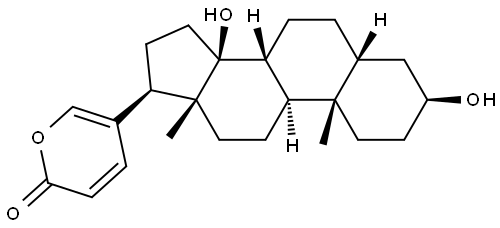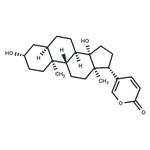Pharmacological effects
Bufalin is one of the main components of dried secretions of toad which is Bufo , Bufalin has a strong surface anesthetic effect, and it has a long-lasting effect in rabbit cornea and human tongue tests which is stronger than cocaine, about 90 times of cocaine. intravenous fluid Toad (0.05mg/kg) on Anesthetized rabbits , anesthetized rabbits can be caused breathing excitement, cat can also be caused breathe excitement . Its effect is stronger than nikethamide , pentylenetetrazol, lobeline, etc. and it can antagonize morphine respiratory depression. Respiratory stimulant order: Bufalin>Resibufogenin= Cinobufagin =cinobufotaline> Japanese toad toxins.
Bufalin low concentrations (10-4) promote release of presynaptic acetylcholine on rat diaphragm , while high concentrations promote first then inhibit, and partly antagonize the neuromuscular blocking effects of Mg2 +,but no inhibition on choline esterase.
The above information is edited by the Chemicalbook of Tian Ye.
Category
Toxic substances
Toxicity grading
Highly toxic
Acute toxicity
Intraperitoneal-mouse LD50: 2.2 mg/kg
Flammability and hazard characteristics
Flammable,the fire produces acrid smoke .
Storage Characteristics
Ventilated, low-temperature ,dry storeroom,separate from food raw materials .
Extinguishing agent
Water, carbon dioxide, dry powder,sandy soil
Uses
A bufadienolide derivative, cardiac steroid, a component of bufadienolides present in the traditional Chinese medicine Chan'su, used therapeutically for the treatment of heart disease, also has been reported as a protective factor in many tumors.
Uses
Bufalin has been used:
- to test its effect on invasion and activation of nuclear factor kappa- B (NF-κB) cells and tumor necrosis factor-α (TNF-α) stimulated rheumatoid arthritis fibroblast-like synoviocytes (RAFLSs)
- as a nuclear receptor coactivator 3 (NCOA3) inhibitor in chondrocytes
- to test its anti-metastasis effect in lung cancer cells (NCI-H460) resistant to gefitinib
Definition
ChEBI: A 14beta-hydroxy steroid that is bufan-20,22-dienolide having hydroxy substituents at the 5beta- and 14beta-positions. It has been isolated from the skin of the toad Bufo bufo.
General Description
Bufalin is a C-24 steroid with an α-pyrone ring positioned at C-17. It is present in the venom glands and skin of toad,
Venenum Bufonis. Bufalin is a cardiotonic steroid and is digoxin-like component of Chan Su.
Biochem/physiol Actions
Bufalin is an anti-metastasis drug, which elicits anti-tumor functionality by favoring cell cycle arrest and apoptosis in various cancer types including hepatocellular, bladder and osteosarcoma. It also promotes autophagic cell death and possesses anti-inflammatory properties. Bufalin is a steroid receptor coactivator (SRC) inhibitor.
Enzyme inhibitor
This cardioactive C-24 steroid (FW = 386.52 g/mol; CAS 465-21-4; Solubility: 5 mg/mL chloroform, 25 mg/mL DMSO), also named 3,14- dihydroxybufa-20,22-dienolide;5β,20(22)-bufadienolide-3β,14-diol and 3β,14-dihydroxy-5β,20(22)-bufadienolide, is the major digoxin-like immunoreactive component of Chansu, a traditional Chinese medicine prepared from the skin and venom-containing parotid gland of a poisonous toad. Bufalin increases the doubling time of three prostate cancer cell lines, inducing apoptosis and the caspase-3 activity. Expression of other proapoptoptic factors, such as mitochondrial Bax and cytosolic cytochrome c, were also increased. Bufalin also reduces serum-induced invasiveness of human hepatocellular cancer SK-Hep1 cells, markedly inhibiting MMP-2 and MMP-9 activities. It also attenuates phosphoinisitide-3-kinase (PI3K) and AKT phosphorylation was associated with reduced levels of NF- κB. Bufalin also suppresses protein levels of FAK, Rho A, VEGF, MEKK3, MKK7, and uPA. Such observations indicate that bufalin is as an antiinvasive agent that inhibits MMP-2 and -9 and alters PI3K/AKT and NF- κB signaling pathways.




